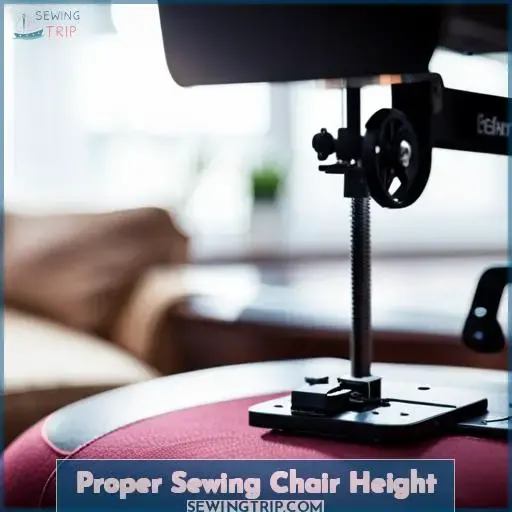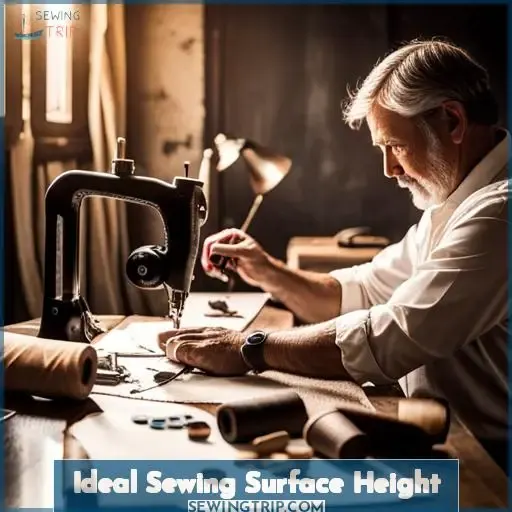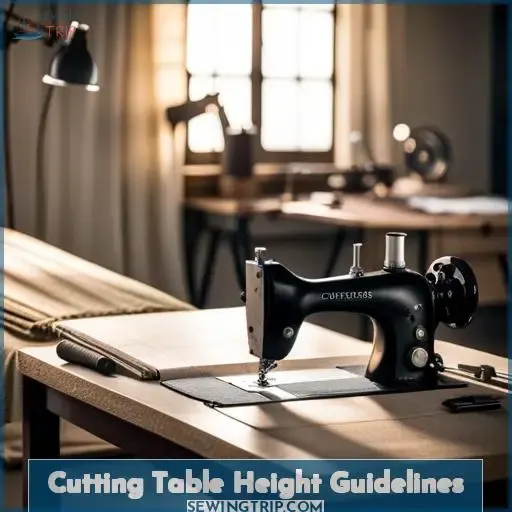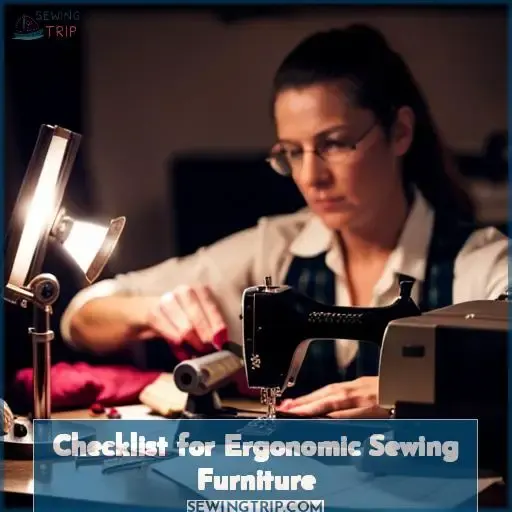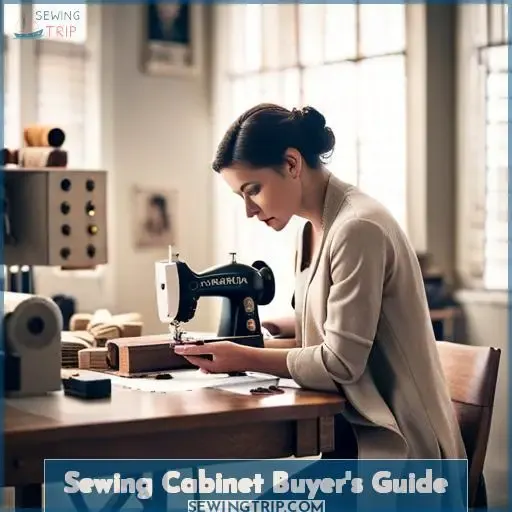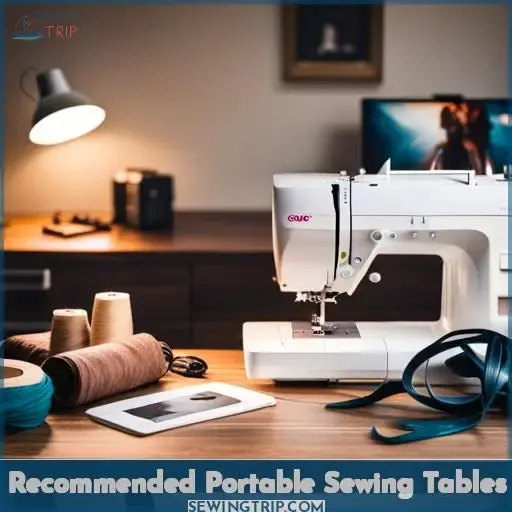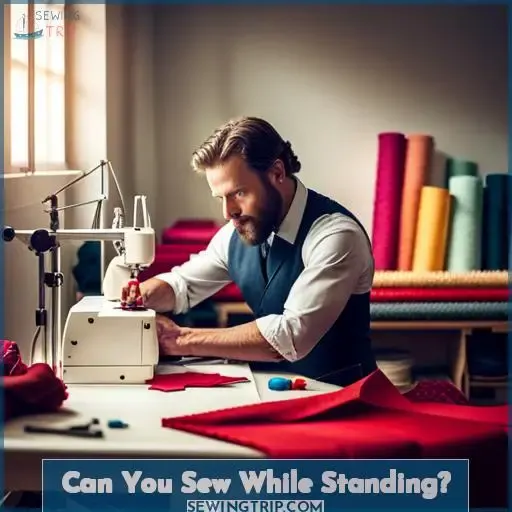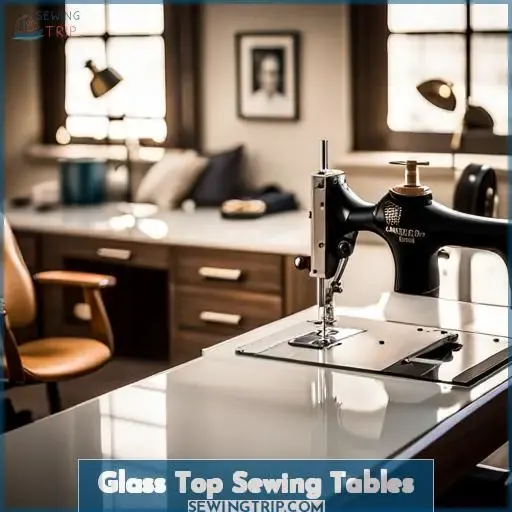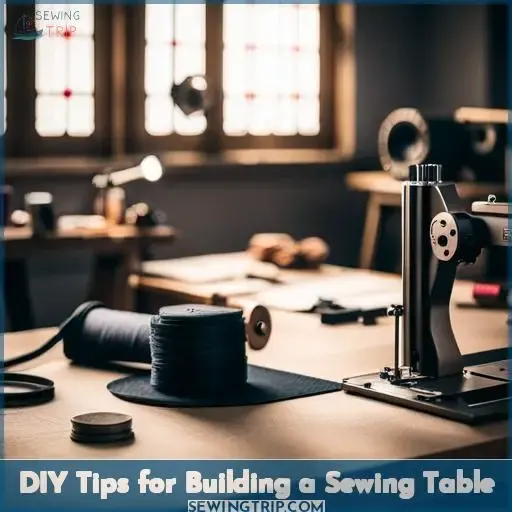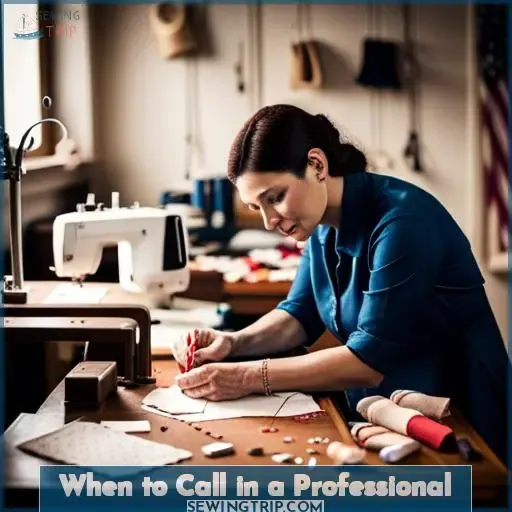This site is supported by our readers. We may earn a commission, at no cost to you, if you purchase through links.
 Ever hunch over your sewing machine, back aching as you try to see those tiny stitches?
Ever hunch over your sewing machine, back aching as you try to see those tiny stitches?
An improperly set up sewing station strains your body unnecessarily.
Let’s fix that!
Measuring your ideal sewing furniture height takes just minutes and saves hours of discomfort.
With a few tweaks, you can customize your sewing spot for pain-free projects and properly align that focus keyword – your elbow – to the sewing surface.
Now breathe easy as we create your custom crafting comfort zone.
Table Of Contents
- Key Takeaways
- Proper Sewing Chair Height
- Ideal Sewing Surface Height
- Cutting Table Height Guidelines
- Checklist for Ergonomic Sewing Furniture
- Sewing Cabinet Buyer’s Guide
- Recommended Portable Sewing Tables
- Can You Sew While Standing?
- Glass Top Sewing Tables
- DIY Tips for Building a Sewing Table
- When to Call in a Professional
- Frequently Asked Questions (FAQs)
- Conclusion
Key Takeaways
- Set the sewing chair height so thighs are slightly sloping and knees are bent at 90 degrees.
- The ideal sewing surface height is around elbow level when seated properly in the chair.
- Consider adjustable height sewing furniture to allow customization, like chairs, tables and cutting surfaces.
- For a DIY sewing table, customize the height based on body measurements and posture.
Proper Sewing Chair Height
Your chair height should position your body at right angles to promote correct sewing posture and prevent strain.
Sit with your thighs sloping slightly more than 90 degrees to the floor and knees bent at a 90-degree angle.
Consider investing in an adjustable drafting chair that allows your posture to remain upright while bringing your elbows to the proper sewing surface height.
Portable options like saddle stools offer even more flexibility to shift positions.
Follow basic ergonomic guidelines for chair adjustability, but also listen to your body’s signals and customize as needed – arm rests, cushions, or back supports.
Experiment with small tweaks over time to dial in ideal comfort for marathon sewing or cutting sessions.
Ideal Sewing Surface Height
When determining the ideal height for your sewing table, start by following OSHA’s guideline to set it equal to your elbow height when seated properly.
However, many experts recommend adding 5 1⁄2 – 7 inches to your elbow height measurement for a more ergonomic set-up.
Let’s take a closer look at why there are differing viewpoints on the optimal sewing surface height.
Elbow Measurement Method
One method for determining the ideal sewing surface height is to:
- Measure from elbow to floor.
- Add 5 1/2 to 7 inches.
Ensure proper posture and adjust the height for comfort.
OSHA Recommendations
You should set your sewing table height based on OSHA’s guideline that matches your elbow height to the sewing surface while seated properly.
| Surface | OSHA Guideline |
|---|---|
| Sewing | Elbow height |
| Cutting | Elbow height + 2-3 inches |
| Ironing | Several inches below elbow height |
Following OSHA’s recommendations ensures your sewing furniture promotes good ergonomics and posture, reducing discomfort while quilting.
Cutting Table Height Guidelines
Determine your ideal cutting surface height by standing straight with elbows bent at 90 degrees, lightly touching the table’s surface; adjust the height until this posture feels comfortable.
As a tailor and seamstress focused on ergonomics, I recommend this simple test to find your optimal cutting height. The goal is to reduce strain while providing adequate workspace for tracing patterns and cutting fabric.
For most people, a table height around 36 inches allows proper elbow positioning.
Consider incorporating an adjustable-height cutting table into your sewing room remodel. With the proper furniture heights, you can quilt, sew garments, and prep fabric in comfort.
I offer advice on sewing table options and ergonomic guidelines to create the ultimate sewing sanctuary.
Checklist for Ergonomic Sewing Furniture
As you evaluate furniture options for your sewing room, prioritize adjustable chair height and sturdy table construction.
The ability to properly position yourself at various work stations reduces strain and discomfort over extended periods.
Keep this checklist in mind as you select pieces that allow you to sew comfortably while maintaining proper posture.
Chair Adjustability
After discussing cutting table heights, check if your sewing chair adjusts high enough for you to sit comfortably at the sewing machine with your back straight and elbows bent at 90 degrees.
Consider an adjustable seat, ergonomic posture, various chair options to customize height, and sewing comfort.
The right chair allows good angles for your knees, hips, and elbows so you can sew properly without strain.
Sturdy Construction
Evaluate the construction of your sewing furniture to ensure it’s sturdy and durable, prioritizing stability for optimal ergonomics.
When selecting a sewing table, look for durable design features like reinforced joints, thick tabletops, sturdy legs, and stability bars. Quality construction materials like steel, hardwoods, and laminates withstand heavy use over years.
Prioritize robust framework and long-lasting build to support correct posture and comfort during extended sewing sessions.
Consider adjustable height and width capabilities as well.
Sewing Cabinet Buyer’s Guide
So when you’re shopping for a sewing cabinet, first consider whether you need enclosed storage or an open design based on your available space and how you intend to use it.
Look at sewing cabinet styles like stationary units, fold-away options, and portable rolling carts to determine what best suits your sewing room layout and projects.
Prioritize storage solutions like drawers, shelves, baskets, and trays that organize thread, fabric, patterns, notions, and other essentials.
Ensure chair comfort and machine compatibility by selecting adjustable table heights and widths, sturdy smooth-glide drawers, and inserts for your specific machine model.
Carefully evaluate table materials like wood, metal, and acrylic for durability, ease of cleaning, and aesthetic appeal.
Reading sewing table reviews can provide helpful insight into real customer experiences with various cabinets.
With some thoughtful consideration of your needs, you’ll find the ideal sewing furniture to inspire your creativity.
Recommended Portable Sewing Tables
After selecting the ideal sewing cabinet for your space, you may desire a portable sewing table for flexibility.
When evaluating portable options, first decide if height adjustability is essential for you.
Next, determine if the table offers adequate workspace and storage for your projects.
Finally, choose a budget-friendly pick that suits your decor.
Useful portable tables include:
- Sew Ready Eclipse Sewing Machine Cabinet with its spacious surface and interior storage
- Arrow Sewing Cabinets Sara Cabinet for its classic style and lift mechanism
- Southern Enterprises Folding Sewing Craft Table for its honeycomb shelves and butterfly leaf
Can You Sew While Standing?
Have you considered sewing while standing?
Electric standing desks and bar-height tables allow you to sew in an upright position.
Evaluating options like Famisky’s adjustable electric standing desk or Mr. Ironstone’s bar-style table can help determine if standing sewing meets your ergonomic and space needs.
Electric Standing Desks
Depending on your preference and physical needs, you’d do well to consider an electric standing desk for sewing while standing up.
Options like the Famisky Adjustable Height Electric Standing Desk allow you to easily adjust the height at the push of a button. This accommodates both sitting and standing postures, with features like rounded corners and a spacious work surface for your sewing projects.
Standing while sewing provides ergonomic benefits but also requires proper table height – keep this in mind when evaluating electric standing desks.
Bar-Height Tables
You can also consider bar-height tables for standing sewing.
These allow you to stand comfortably at your machine without needing a specialty standing desk.
Seek out adjustable bar-style tables offering customizable dimensions fitting your space and body.
Creative solutions like commercial-grade tables allow adjusting leg lengths, bringing sewing machines to suitable heights for proper wrist alignment while standing.
Compact bistro sets work for small spaces too.
Glass Top Sewing Tables
When considering a glass top sewing table, think about tempered glass desks or round dining tables that you can repurpose.
These types of tables generally provide ample workspace while allowing light to shine through.
Just be sure to test the table’s height and stability with your machine before committing to a glass top.
Tempered Glass Desks
Your tempered glass desk provides a smooth surface for sewing while allowing light to pass through.
Scratch-resistant
Heat-tolerant
Customizable sizes
Versatile styles
With proper care like using desk pads and gentle cleaners, a glass-top sewing table offers durability, translucency, and design flexibility to fit your space.
Round Dining Tables
A round dining table with a glass top can pull double duty as your sewing station.
The circular design and transparent surface impart an airy, yet elegant vibe.
Trendy pedestal bases maximize legroom while smaller round tables optimize space.
Their versatile seating welcomes sewing friends or dinner guests.
Evaluate round tables based on dimensions, storage, features, and versatility to meet your sewing space and lifestyle needs.
| Feature | Benefit |
|---|---|
| Circular Design | Airy, spacious feel |
| Glass Top | Transparent, elegant aesthetic |
| Pedestal Base | Maximize legroom |
| Smaller Size | Optimize space |
| Versatile Seating | Accommodate sewing and dining |
DIY Tips for Building a Sewing Table
After discussing glass top sewing tables, several of you may want to try building your own sewing table to meet your personal ergonomic needs.
Here are some DIY tips for creating a customized and budget-friendly sewing table:
- Customized Dimensions: Determine the ideal height and size for your specific needs by considering your body measurements and preferred working posture.
- Budget-Friendly Designs: Look for affordable materials such as plywood or repurpose an existing piece of furniture to save money while still achieving functionality.
- Adjustable Features: Incorporate adjustable elements like height-adjustable legs or a tilting tabletop to accommodate different tasks and promote proper ergonomics.
- Stylish Finishes: Add a touch of personal style with paint, stain, or decorative finishes that complement the overall aesthetics of your sewing room while providing durability.
By following these DIY tips, you can create a space-saving solution that promotes comfort and efficiency in your sewing room organization while keeping within budget constraints.
When to Call in a Professional
After trying your hand at building a DIY sewing table, consider calling in a professional if the project proves too complex or time-consuming for your skill level.
Reasons to Seek Help:
- Meeting ergonomic guidelines
- Customized storage solutions
- Specialized features
- Precise sizing and proportions
- Limited tools or workspace
Professional Services:
- Ergonomic evaluations
- Design consultations
- Furniture construction
- Delivery and installation
- Ongoing maintenance
Seeking expert assistance can help ensure your sewing furniture meets both functional and ergonomic needs. Professionals offer services like ergonomic analysis, custom furniture building with specialized features, and handling delivery and setup.
This expertise allows crafting precisely fitted, comfortable sewing stations for seamless creativity.
Frequently Asked Questions (FAQs)
What sewing table height is best for children?
For proper ergonomics, adjust the sewing table height so your child’s:
- Thighs are parallel to the floor
- Knees are bent at a 90-degree angle
- Feet are flat
This allows them to sit up straight without strain.
Check their posture regularly as they grow.
Should my sewing chair have arms or be armless?
Your sewing chair should have adjustable arms.
They support your posture while allowing access to the machine.
Choose a model with removable arms for maximum flexibility between open access and supported sewing.
How much sewing table workspace do I really need?
You need enough table space for cutting, piecing, and pressing.
But don’t go overboard – workspace can inspire clutter.
Focus on a size that promotes an uncluttered, creative flow.
Is it better to buy a sewing cabinet or build my own sewing table?
Buy a sewing cabinet tailored to your space, machine, and storage needs.
But build a sewing table if you crave a custom workspace.
The ideal solution blends function, style, and budget.
What’s the difference between a sewing station and a sewing desk?
A station is a dedicated area for a specialized task.
A desk provides a surface for general work.
So a sewing station focuses on sewing activities,
while a sewing desk offers a height-adjustable surface to support sewing alongside other crafts or office tasks.
Conclusion
So, don’t let your sewing projects turn into hunching horrors. Take a load off with furniture that fits like your favorite pair of jeans.
Making a few simple adjustments tailored to your measurements can transform any table into a discomfort-free zone.
Now, you can stitch, cut, and craft to your heart’s content without straining your back or eyes.
Creating your personalized sewing spot ensures many more years of happy hemming ahead!

